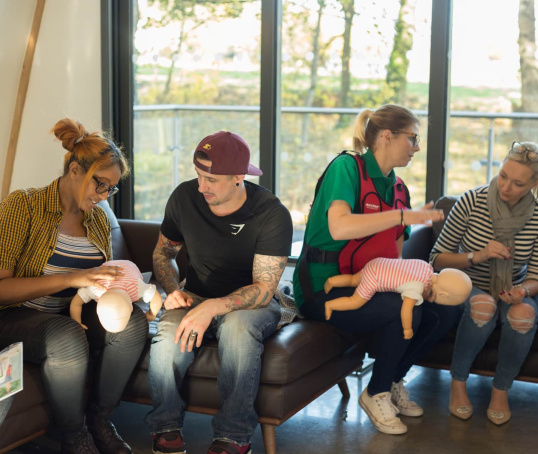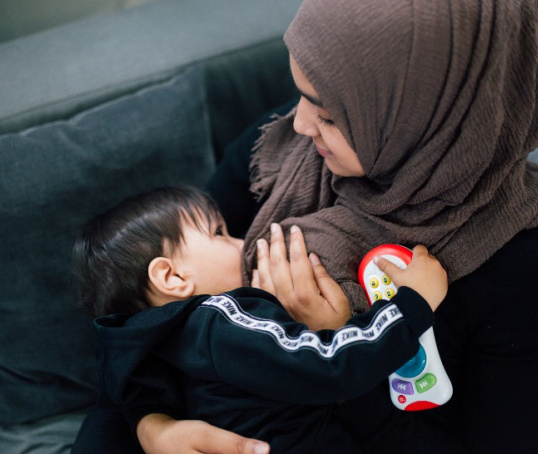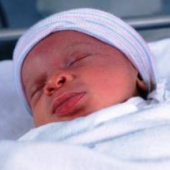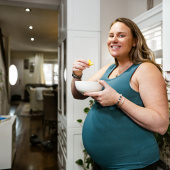If your baby has prolonged jaundice, they might be referred for a split bilirubin blood test. Here we talk about the test and what the results might mean.
Why does my baby need a split bilirubin blood test?
If your baby’s had prolonged jaundice, they may be offered a split bilirubin blood test (CLDF, 2019b). The split bilirubin test checks your baby’s blood for the ratio of conjugated and unconjugated bilirubin. This test will help to check whether your baby’s jaundice is caused by an underlying condition like liver disease (CLDF, 2019b).
What is unconjugated and conjugated bilirubin?
Bilirubin is a yellow substance we produce throughout our lives as we break down the haem part of the haemoglobin from our red blood cells. Babies are born with a higher number of red blood cells than they need, so this breakdown is most pronounced in the first two weeks of life (CDLF, 2019a).
We change haem into unconjugated bilirubin (not water-soluble) and our livers change that unconjugated bilirubin into conjugated bilirubin (water-soluble). This conjugated bilirubin is a waste product that goes into our bile, then the intestine; it’s this broken-down bilirubin in bile that gives poo its brown colour.
At birth the liver is not completely mature, even if the baby is full term, so it may not be able to process the unconjugated bilirubin as quickly as it is made. This causes it to build up in the body and bloodstream, making a baby appear jaundiced or yellow (CLDF, 2019a).
Other possible causes of jaundice
Very rarely, if a baby has a blockage or inflammation in their liver or their biliary drainage system, the bile containing bilirubin might stop draining from their liver. This will mean their poo will look pale and their wee yellow (CLDF, 2019a). You can check the colour of your baby’s poos against this chart.
What is the split bilirubin test?
Your baby may be offered a blood test called a split bilirubin blood test. This test measures the ratio of the conjugated and unconjugated bilirubin levels in your baby's blood (CLDF, 2019b).
Results that might indicate a problem
1. High levels of unconjugated bilirubin (unconjugated hyperbilirubinaemia)
A raised level of unconjugated bilirubin is relatively common (CDLF, 2019b). However, treatment for high levels of unconjugated bilirubin may be necessary because in rare cases it could cause brain damage (kernicterus) (NHS, 2018).
2. Presence of conjugated bilirubin (conjugated hyperbilirubinaemia)
If your baby’s conjugated bilirubin is more than 20% of the total bilirubin, this suggests they may have liver disease. A specialist paediatric liver unit will further investigate your baby’s condition (CLDF, 2019a).
Treatment for high levels of unconjugated bilirubin (unconjugated hyperbilirubinaemia)
It is very rare for unconjugated bilirubin to be caused by a problem in the liver (CDLF, 2019a). Most babies will not need any treatment as their jaundice will have gone by the time they’re two weeks old (or three weeks if premature). A few babies will have to have some treatment, depending on how much unconjugated bilirubin they have in their blood (NHS, 2018).
The normal treatment for high levels of unconjugated bilirubin is phototherapy, which reduces bilirubin levels. If your baby needs this, they’ll be placed naked, except for some eye pads, in a cot under a special blue light. The light breaks down the unconjugated bilirubin. You will be encouraged to feed your baby so your baby produces plenty of wee. Phototherapy usually continues for a few days (NHS, 2018).
How is jaundice due to raised conjugated bilirubin different to that from raised unconjugated bilirubin?
Unlike unconjugated bilirubin, phototherapy does not break down conjugated bilirubin. Therefore, this treatment will not be offered.
On the other hand, conjugated bilirubin can’t pass into the brain so it will not damage the brain (very high levels of unconjugated bilirubin can), so this will not be a concern (CLDF, 2019a). The concern with raised levels of conjugated bilirubin is that it could indicate a problem with the liver.
Conjugated bilirubin can dissolve in water so some of it gets into wee and makes it yellow. Yet poo might be paler because it contains less bile (CLDF, 2019a).
If your baby has raised conjugated bilirubin, they’ll have more fats in their poo because they don’t have as much bile to digest fats. This will make your baby particularly hungry and they might have difficulty gaining the usual amount of weight as they get older. Their liver might also be larger than usual because of the inflammation and swelling from the trapped bile (CLDF, 2019a).
How will my baby’s raised conjugated bilirubin (hyperbilirubinaemia) be investigated?
Your local hospital or a specialist centre might investigate why your baby has raised conjugated bilirubin and whether they need any special treatment (CLDF, 2019a). Your baby might have the following investigations:
- an examination by a doctor
- blood tests
- urine tests
- stool examination or tests
- an ultrasound scan
- specialised scans
- a liver biopsy
- X-ray
- an eye test
- a heart test
- a bone marrow test.
(CLDF, 2019a)
What usually causes conjugated hyperbilirubinaemia?
While conjugated jaundice can be caused by a lot of different things, these causes can be grouped into the following:
- Bile duct drainage issues mean that the bile ducts have an abnormality. One such condition is biliary atresia, which is where bile ducts outside of the liver collapse or disappear and obstruct bile flow.
- Metabolic conditions mean liver cells have an abnormality in how they make or pass out bile, or in how they metabolise nutrients from your baby’s milk.
- Unknown. Up to a third of all babies who test positive for raised conjugated bilirubin do not have a known cause for it. Babies who experienced other medical problems soon after they were born more often have unknown causes of raised conjugated bilirubin.
(CLDF, 2019a)
Treatment for conjugated hyperbilirubinaemia
Your baby might need special feeds and medication to help them deal with poor bile flow until it improves (CLDF, 2019a).
Doctors might start treatments like:
- a special diet
- medication
- an operation.
(CLDF, 2019a)
Is conjugated hyperbilirubinaemia serious?
This depends on why your baby has conjugated hyperbilirubinaemia, because conjugated bilirubin on its own is not serious (CLDF, 2019a).
If doctors can’t identify a cause, your baby is likely to progress well, with their jaundice gradually clearing over weeks (or months) with no long-term ill effect. Some children will continue to have ongoing liver problems and will need further treatment. That’s why all babies with high levels of conjugated bilirubin are followed up (CLDF, 2019a).
If you have concerns about jaundice that isn’t getting better, your baby has very pale poo or yellow urine or you are concerned about your baby’s health, you can always contact your GP or health visitor for advice.
NHS Choices and the Children's Liver Disease Foundation have more information about newborn jaundice and liver disease in babies.
The Children's Liver Disease Foundation is dedicated to fighting all forms of childhood liver disease. Their Yellow Alert campaign promotes the early diagnosis of liver disease in newborns.
This page was last reviewed in March 2021.
Further information
Our support line offers practical and emotional support with feeding your baby and general enquiries for parents, members and volunteers: 0300 330 0700.
NHS Choices and the Children’s Liver Disease Foundation have more information about newborn jaundice and liver disease in babies.
The Children’s Liver Disease Foundation is dedicated to fighting all forms of childhood liver disease. Their Yellow Alert campaign promotes the early diagnosis of liver disease in newborns.
CLDF (Children’s Liver Disease Foundation). (2019a) Baby jaundice and liver disease. Available at: https://childliverdisease.org/wp-content/uploads/2020/02/20190103-Baby-Jaundice-and-Liver-Disease.pdf [Accessed 25 March 2021].
CLDF (Children’s Liver Disease Foundation). (2019b) Baby jaundice. Available at: https://childliverdisease.org/liver-information/baby-jaundice/ [Accessed 25 March 2021].
NHS. (2018) Newborn jaundice. Available at: https://www.nhs.uk/conditions/jaundice-newborn/ [Accessed 25 March 2021].







